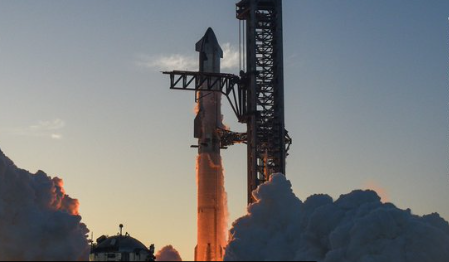A study by Russian scientists has unveiled that a high-altitude explosion of SpaceX’s Starship rocket last year caused a temporary hole in the upper atmosphere, marking the first instance of such a disruption resulting from a human-made explosion. This event took place during a test flight from SpaceX’s facility in Boca Chica, Texas, on November 18, 2023.
‘Catastrophic’ SpaceX Starship explosion tore a hole in the atmosphere last year https://t.co/NjAA3s09Uv pic.twitter.com/9xYZHHUwcR
— DomPachino101 (@DomPachino101) August 31, 2024
Approximately four minutes post-launch, the rocket’s first stage detached as intended but exploded unexpectedly before it could return to Earth. Shortly thereafter, the remaining structure of the rocket disintegrated about 93 miles above the ground due to a fire triggered by venting liquid oxygen. Elon Musk, SpaceX’s CEO, later speculated that the mission could have reached orbit if the rocket had been carrying a proper payload.
Published in the journal “Geophysical Research Letters” on August 26, the findings detail how the second explosion created a significant hole in the ionosphere—a layer of Earth’s atmosphere where gases are ionized by solar radiation. This disruption was primarily due to the shock wave from the explosion, which scattered free electrons and disrupted the plasma state within the ionosphere.
The gigantic explosions that destroyed SpaceX’s Starship mega-rocket last year also blew one of the biggest ‘holes’ ever detected in the ionosphere, high above Earth. https://t.co/5GPTHCwWjt
— nature (@Nature) August 30, 2024
The disturbance was monitored by multiple satellites and ground stations globally, lasting about 30 to 40 minutes before the ionosphere returned to normal. This phenomenon differs from typical ionospheric holes, which are usually formed by chemical interactions between rocket exhaust and ionized gases, leading to recombination of oxygen atoms and temporary gaps in the plasma.
SpaceX’s Falcon 9 rockets are known to create similar disturbances, typically producing aurora-like light displays in the sky. However, the Starship explosion did not result in such a visual spectacle, possibly because the ionospheric hole was not primarily caused by chemical processes but by the physical dispersion of electrons.
“‘Catastrophic’ SpaceX Starship explosion tore a hole in the atmosphere last year in 1st-of-its-kind event, Russian scientists reveal” on SmartNews: https://t.co/uX8MTZXArG #SmartNews
— Michael Drysch (@HalfCourtMikeD) August 31, 2024
The study emphasizes the need for further research into the effects of ionospheric holes and their impact on Earth’s atmosphere. This incident provides a unique opportunity to advance understanding of ionospheric dynamics and the interactions within this high-altitude layer of plasma. Additionally, this was the second explosion of a SpaceX Starship in consecutive test flights, with the previous incident occurring at a lower altitude that did not affect the ionosphere.
Major Points:
- A SpaceX Starship rocket explosion in November 2023 created a temporary hole in the ionosphere, the first known instance caused by a human-made explosion, according to Russian scientists.
- The rocket disintegrated approximately 93 miles above the ground during a test flight from Boca Chica, Texas, following an unplanned detonation of the first stage.
- The study, published in “Geophysical Research Letters,” indicates the hole in the ionosphere was primarily due to a shock wave that dispersed electrons, disrupting the plasma layer.
- Unlike typical ionospheric disturbances caused by rocket chemicals, this event did not produce an aurora-like light display, as the hole resulted from physical rather than chemical effects.
- The phenomenon was monitored globally and lasted about 30 to 40 minutes, underscoring the need for further research into ionospheric disturbances and their broader atmospheric implications.
Conner T – Reprinted with permission of Whatfinger News

